TAEDES401/TAEDES402: Competency-Based Learning Program Design Project
VerifiedAdded on 2023/06/11
|25
|5896
|172
Project
AI Summary
This project outlines the design and development of a competency-based learning program addressing the requirements of the BSBOPS304 unit of competency from a nationally recognized training package. The project details the target learner group, program parameters, and the collaboration involved in the design process, including feedback from customer care representatives, supervisors, and hospital patients. It includes an analysis of the unit of competency, qualification information, a learning program review questionnaire, a learning program plan with a risk control plan, a competency matrix, and evidence of incorporating foundation skills. The project emphasizes client-focused, safe, and adult learning principles, reflecting the dimensions of competency and instructional design.
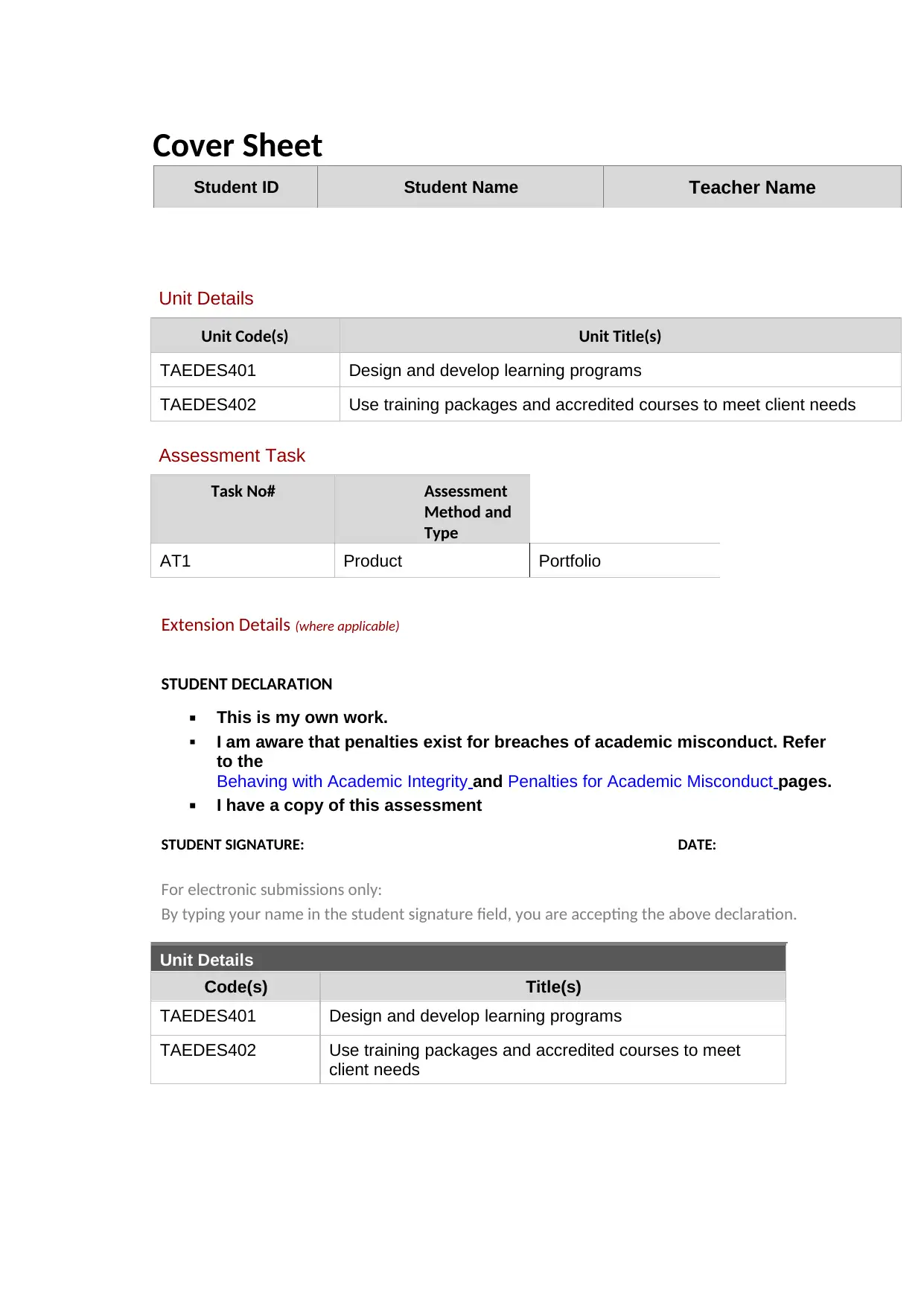
Cover Sheet
Student ID Student Name Teacher Name
Unit Details
Unit Code(s) Unit Title(s)
TAEDES401 Design and develop learning programs
TAEDES402 Use training packages and accredited courses to meet client needs
Assessment Task
Task No# Assessment
Method and
Type
AT1 Product Portfolio
Extension Details (where applicable)
STUDENT DECLARATION
This is my own work.
I am aware that penalties exist for breaches of academic misconduct. Refer
to the
Behaving with Academic Integrity and Penalties for Academic Misconduct pages.
I have a copy of this assessment
STUDENT SIGNATURE: DATE:
For electronic submissions only:
By typing your name in the student signature field, you are accepting the above declaration.
Unit Details
Code(s) Title(s)
TAEDES401 Design and develop learning programs
TAEDES402 Use training packages and accredited courses to meet
client needs
Student ID Student Name Teacher Name
Unit Details
Unit Code(s) Unit Title(s)
TAEDES401 Design and develop learning programs
TAEDES402 Use training packages and accredited courses to meet client needs
Assessment Task
Task No# Assessment
Method and
Type
AT1 Product Portfolio
Extension Details (where applicable)
STUDENT DECLARATION
This is my own work.
I am aware that penalties exist for breaches of academic misconduct. Refer
to the
Behaving with Academic Integrity and Penalties for Academic Misconduct pages.
I have a copy of this assessment
STUDENT SIGNATURE: DATE:
For electronic submissions only:
By typing your name in the student signature field, you are accepting the above declaration.
Unit Details
Code(s) Title(s)
TAEDES401 Design and develop learning programs
TAEDES402 Use training packages and accredited courses to meet
client needs
Paraphrase This Document
Need a fresh take? Get an instant paraphrase of this document with our AI Paraphraser
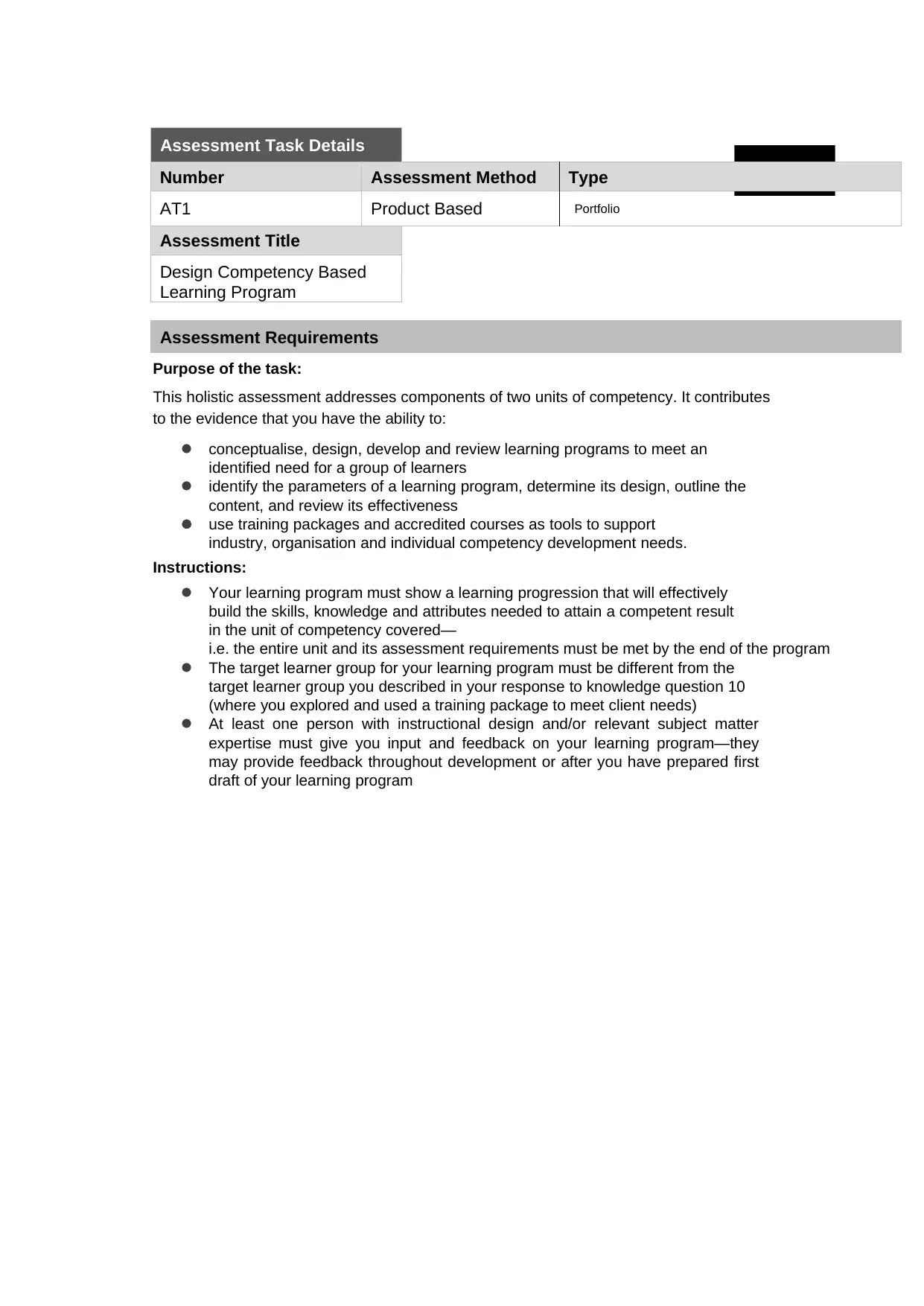
Assessment Task Details
Number Assessment Method Type
AT1 Product Based Portfolio
Assessment Title
Design Competency Based
Learning Program
Assessment Requirements
Purpose of the task:
This holistic assessment addresses components of two units of competency. It contributes
to the evidence that you have the ability to:
l conceptualise, design, develop and review learning programs to meet an
identified need for a group of learners
l identify the parameters of a learning program, determine its design, outline the
content, and review its effectiveness
l use training packages and accredited courses as tools to support
industry, organisation and individual competency development needs.
Instructions:
l Your learning program must show a learning progression that will effectively
build the skills, knowledge and attributes needed to attain a competent result
in the unit of competency covered—
i.e. the entire unit and its assessment requirements must be met by the end of the program
l The target learner group for your learning program must be different from the
target learner group you described in your response to knowledge question 10
(where you explored and used a training package to meet client needs)
l At least one person with instructional design and/or relevant subject matter
expertise must give you input and feedback on your learning program—they
may provide feedback throughout development or after you have prepared first
draft of your learning program
Number Assessment Method Type
AT1 Product Based Portfolio
Assessment Title
Design Competency Based
Learning Program
Assessment Requirements
Purpose of the task:
This holistic assessment addresses components of two units of competency. It contributes
to the evidence that you have the ability to:
l conceptualise, design, develop and review learning programs to meet an
identified need for a group of learners
l identify the parameters of a learning program, determine its design, outline the
content, and review its effectiveness
l use training packages and accredited courses as tools to support
industry, organisation and individual competency development needs.
Instructions:
l Your learning program must show a learning progression that will effectively
build the skills, knowledge and attributes needed to attain a competent result
in the unit of competency covered—
i.e. the entire unit and its assessment requirements must be met by the end of the program
l The target learner group for your learning program must be different from the
target learner group you described in your response to knowledge question 10
(where you explored and used a training package to meet client needs)
l At least one person with instructional design and/or relevant subject matter
expertise must give you input and feedback on your learning program—they
may provide feedback throughout development or after you have prepared first
draft of your learning program
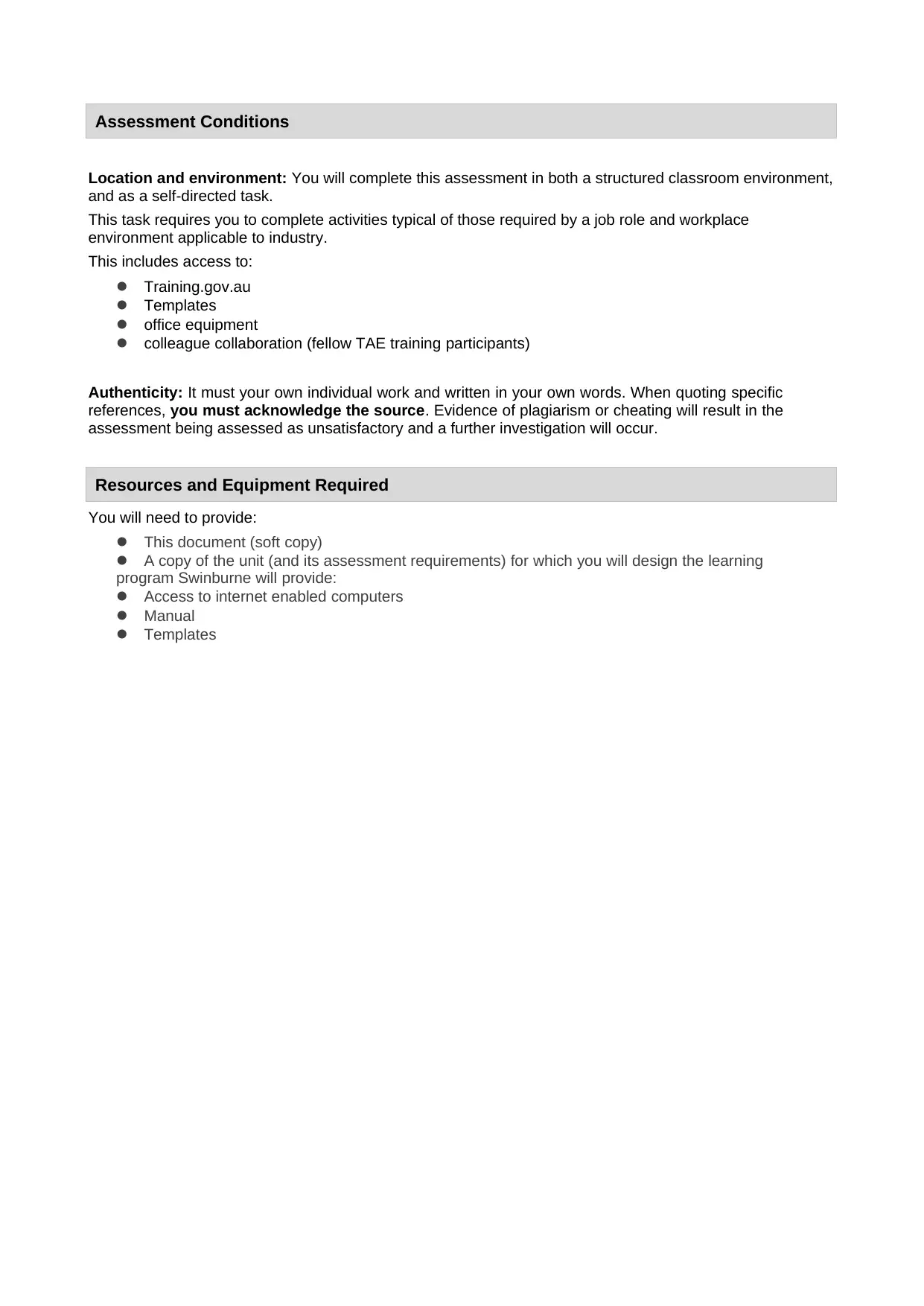
Assessment Conditions
Location and environment: You will complete this assessment in both a structured classroom environment,
and as a self-directed task.
This task requires you to complete activities typical of those required by a job role and workplace
environment applicable to industry.
This includes access to:
l Training.gov.au
l Templates
l office equipment
l colleague collaboration (fellow TAE training participants)
Authenticity: It must your own individual work and written in your own words. When quoting specific
references, you must acknowledge the source. Evidence of plagiarism or cheating will result in the
assessment being assessed as unsatisfactory and a further investigation will occur.
Resources and Equipment Required
You will need to provide:
l This document (soft copy)
l A copy of the unit (and its assessment requirements) for which you will design the learning
program Swinburne will provide:
l Access to internet enabled computers
l Manual
l Templates
Location and environment: You will complete this assessment in both a structured classroom environment,
and as a self-directed task.
This task requires you to complete activities typical of those required by a job role and workplace
environment applicable to industry.
This includes access to:
l Training.gov.au
l Templates
l office equipment
l colleague collaboration (fellow TAE training participants)
Authenticity: It must your own individual work and written in your own words. When quoting specific
references, you must acknowledge the source. Evidence of plagiarism or cheating will result in the
assessment being assessed as unsatisfactory and a further investigation will occur.
Resources and Equipment Required
You will need to provide:
l This document (soft copy)
l A copy of the unit (and its assessment requirements) for which you will design the learning
program Swinburne will provide:
l Access to internet enabled computers
l Manual
l Templates
⊘ This is a preview!⊘
Do you want full access?
Subscribe today to unlock all pages.

Trusted by 1+ million students worldwide
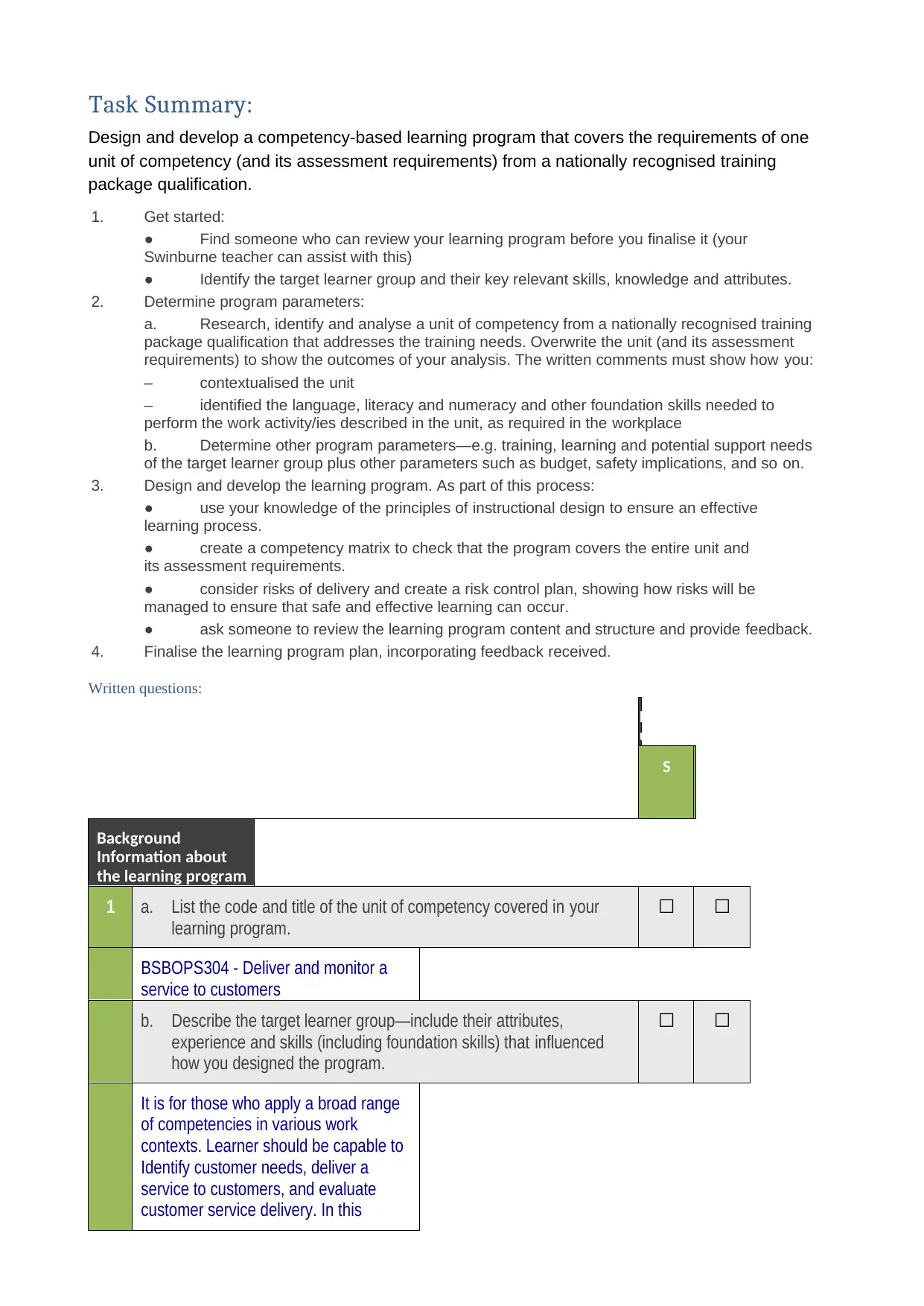
Task Summary:
Design and develop a competency-based learning program that covers the requirements of one
unit of competency (and its assessment requirements) from a nationally recognised training
package qualification.
1. Get started:
● Find someone who can review your learning program before you finalise it (your
Swinburne teacher can assist with this)
● Identify the target learner group and their key relevant skills, knowledge and attributes.
2. Determine program parameters:
a. Research, identify and analyse a unit of competency from a nationally recognised training
package qualification that addresses the training needs. Overwrite the unit (and its assessment
requirements) to show the outcomes of your analysis. The written comments must show how you:
– contextualised the unit
– identified the language, literacy and numeracy and other foundation skills needed to
perform the work activity/ies described in the unit, as required in the workplace
b. Determine other program parameters—e.g. training, learning and potential support needs
of the target learner group plus other parameters such as budget, safety implications, and so on.
3. Design and develop the learning program. As part of this process:
● use your knowledge of the principles of instructional design to ensure an effective
learning process.
● create a competency matrix to check that the program covers the entire unit and
its assessment requirements.
● consider risks of delivery and create a risk control plan, showing how risks will be
managed to ensure that safe and effective learning can occur.
● ask someone to review the learning program content and structure and provide feedback.
4. Finalise the learning program plan, incorporating feedback received.
Written questions:
Res
ults
S N
Background
Information about
the learning program
1 a. List the code and title of the unit of competency covered in your
learning program.
☐ ☐
BSBOPS304 - Deliver and monitor a
service to customers
b. Describe the target learner group—include their attributes,
experience and skills (including foundation skills) that influenced
how you designed the program.
☐ ☐
It is for those who apply a broad range
of competencies in various work
contexts. Learner should be capable to
Identify customer needs, deliver a
service to customers, and evaluate
customer service delivery. In this
Design and develop a competency-based learning program that covers the requirements of one
unit of competency (and its assessment requirements) from a nationally recognised training
package qualification.
1. Get started:
● Find someone who can review your learning program before you finalise it (your
Swinburne teacher can assist with this)
● Identify the target learner group and their key relevant skills, knowledge and attributes.
2. Determine program parameters:
a. Research, identify and analyse a unit of competency from a nationally recognised training
package qualification that addresses the training needs. Overwrite the unit (and its assessment
requirements) to show the outcomes of your analysis. The written comments must show how you:
– contextualised the unit
– identified the language, literacy and numeracy and other foundation skills needed to
perform the work activity/ies described in the unit, as required in the workplace
b. Determine other program parameters—e.g. training, learning and potential support needs
of the target learner group plus other parameters such as budget, safety implications, and so on.
3. Design and develop the learning program. As part of this process:
● use your knowledge of the principles of instructional design to ensure an effective
learning process.
● create a competency matrix to check that the program covers the entire unit and
its assessment requirements.
● consider risks of delivery and create a risk control plan, showing how risks will be
managed to ensure that safe and effective learning can occur.
● ask someone to review the learning program content and structure and provide feedback.
4. Finalise the learning program plan, incorporating feedback received.
Written questions:
Res
ults
S N
Background
Information about
the learning program
1 a. List the code and title of the unit of competency covered in your
learning program.
☐ ☐
BSBOPS304 - Deliver and monitor a
service to customers
b. Describe the target learner group—include their attributes,
experience and skills (including foundation skills) that influenced
how you designed the program.
☐ ☐
It is for those who apply a broad range
of competencies in various work
contexts. Learner should be capable to
Identify customer needs, deliver a
service to customers, and evaluate
customer service delivery. In this
Paraphrase This Document
Need a fresh take? Get an instant paraphrase of this document with our AI Paraphraser
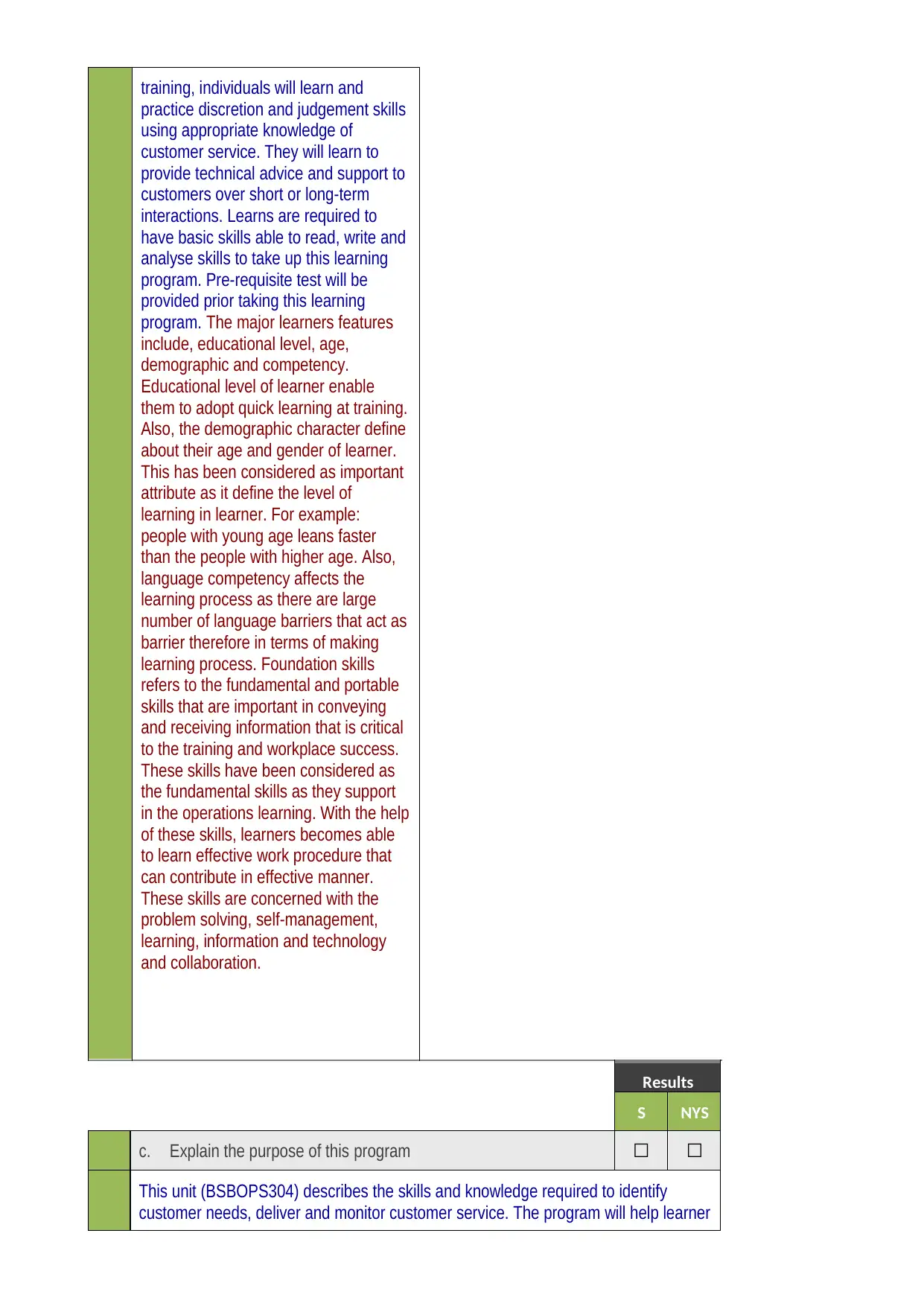
training, individuals will learn and
practice discretion and judgement skills
using appropriate knowledge of
customer service. They will learn to
provide technical advice and support to
customers over short or long-term
interactions. Learns are required to
have basic skills able to read, write and
analyse skills to take up this learning
program. Pre-requisite test will be
provided prior taking this learning
program. The major learners features
include, educational level, age,
demographic and competency.
Educational level of learner enable
them to adopt quick learning at training.
Also, the demographic character define
about their age and gender of learner.
This has been considered as important
attribute as it define the level of
learning in learner. For example:
people with young age leans faster
than the people with higher age. Also,
language competency affects the
learning process as there are large
number of language barriers that act as
barrier therefore in terms of making
learning process. Foundation skills
refers to the fundamental and portable
skills that are important in conveying
and receiving information that is critical
to the training and workplace success.
These skills have been considered as
the fundamental skills as they support
in the operations learning. With the help
of these skills, learners becomes able
to learn effective work procedure that
can contribute in effective manner.
These skills are concerned with the
problem solving, self-management,
learning, information and technology
and collaboration.
Results
S NYS
c. Explain the purpose of this program ☐ ☐
This unit (BSBOPS304) describes the skills and knowledge required to identify
customer needs, deliver and monitor customer service. The program will help learner
practice discretion and judgement skills
using appropriate knowledge of
customer service. They will learn to
provide technical advice and support to
customers over short or long-term
interactions. Learns are required to
have basic skills able to read, write and
analyse skills to take up this learning
program. Pre-requisite test will be
provided prior taking this learning
program. The major learners features
include, educational level, age,
demographic and competency.
Educational level of learner enable
them to adopt quick learning at training.
Also, the demographic character define
about their age and gender of learner.
This has been considered as important
attribute as it define the level of
learning in learner. For example:
people with young age leans faster
than the people with higher age. Also,
language competency affects the
learning process as there are large
number of language barriers that act as
barrier therefore in terms of making
learning process. Foundation skills
refers to the fundamental and portable
skills that are important in conveying
and receiving information that is critical
to the training and workplace success.
These skills have been considered as
the fundamental skills as they support
in the operations learning. With the help
of these skills, learners becomes able
to learn effective work procedure that
can contribute in effective manner.
These skills are concerned with the
problem solving, self-management,
learning, information and technology
and collaboration.
Results
S NYS
c. Explain the purpose of this program ☐ ☐
This unit (BSBOPS304) describes the skills and knowledge required to identify
customer needs, deliver and monitor customer service. The program will help learner
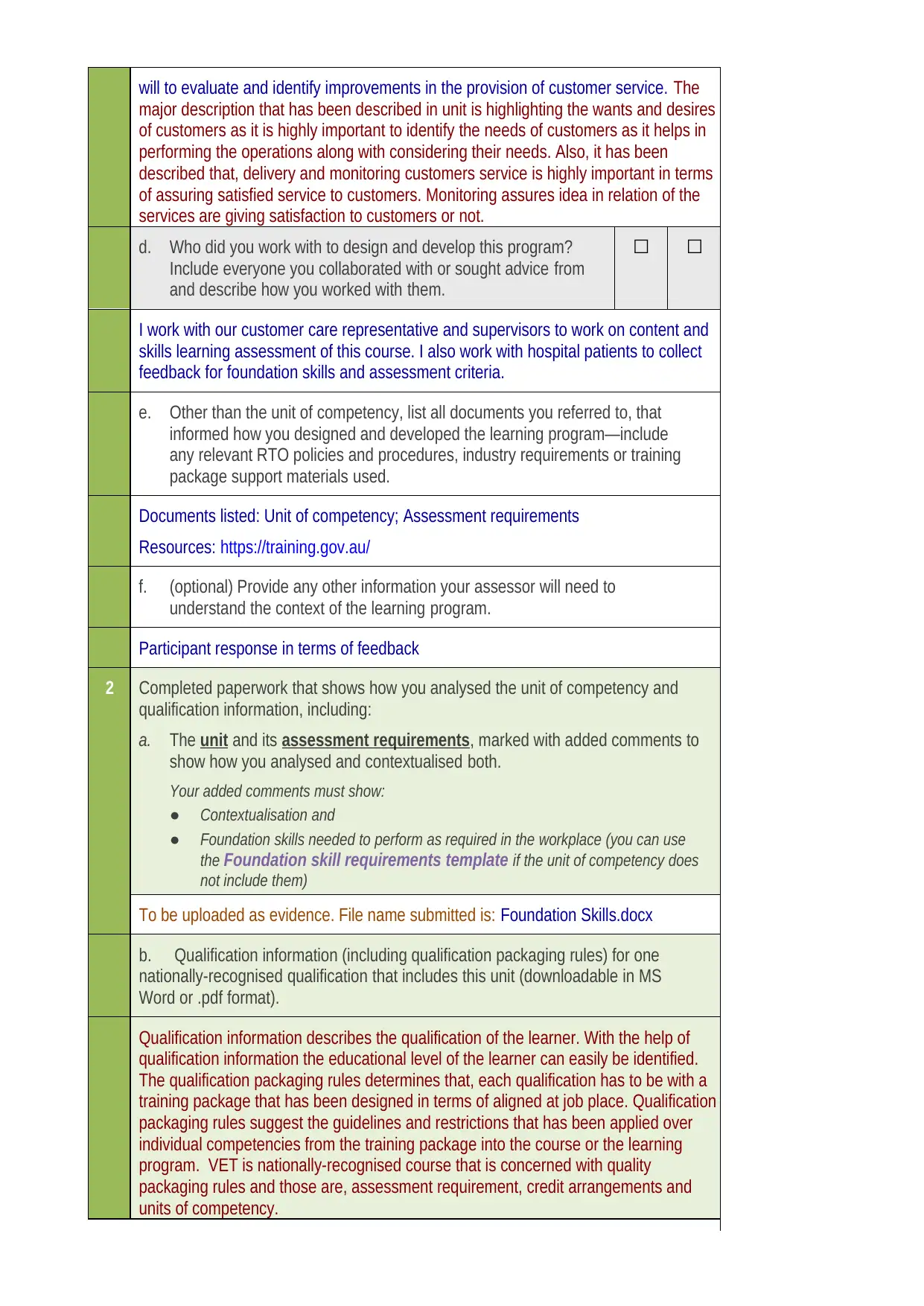
will to evaluate and identify improvements in the provision of customer service. The
major description that has been described in unit is highlighting the wants and desires
of customers as it is highly important to identify the needs of customers as it helps in
performing the operations along with considering their needs. Also, it has been
described that, delivery and monitoring customers service is highly important in terms
of assuring satisfied service to customers. Monitoring assures idea in relation of the
services are giving satisfaction to customers or not.
d. Who did you work with to design and develop this program?
Include everyone you collaborated with or sought advice from
and describe how you worked with them.
☐ ☐
I work with our customer care representative and supervisors to work on content and
skills learning assessment of this course. I also work with hospital patients to collect
feedback for foundation skills and assessment criteria.
e. Other than the unit of competency, list all documents you referred to, that
informed how you designed and developed the learning program—include
any relevant RTO policies and procedures, industry requirements or training
package support materials used.
Documents listed: Unit of competency; Assessment requirements
Resources: https://training.gov.au/
f. (optional) Provide any other information your assessor will need to
understand the context of the learning program.
Participant response in terms of feedback
2 Completed paperwork that shows how you analysed the unit of competency and
qualification information, including:
a. The unit and its assessment requirements, marked with added comments to
show how you analysed and contextualised both.
Your added comments must show:
● Contextualisation and
● Foundation skills needed to perform as required in the workplace (you can use
the Foundation skill requirements template if the unit of competency does
not include them)
To be uploaded as evidence. File name submitted is: Foundation Skills.docx
b. Qualification information (including qualification packaging rules) for one
nationally-recognised qualification that includes this unit (downloadable in MS
Word or .pdf format).
Qualification information describes the qualification of the learner. With the help of
qualification information the educational level of the learner can easily be identified.
The qualification packaging rules determines that, each qualification has to be with a
training package that has been designed in terms of aligned at job place. Qualification
packaging rules suggest the guidelines and restrictions that has been applied over
individual competencies from the training package into the course or the learning
program. VET is nationally-recognised course that is concerned with quality
packaging rules and those are, assessment requirement, credit arrangements and
units of competency.
major description that has been described in unit is highlighting the wants and desires
of customers as it is highly important to identify the needs of customers as it helps in
performing the operations along with considering their needs. Also, it has been
described that, delivery and monitoring customers service is highly important in terms
of assuring satisfied service to customers. Monitoring assures idea in relation of the
services are giving satisfaction to customers or not.
d. Who did you work with to design and develop this program?
Include everyone you collaborated with or sought advice from
and describe how you worked with them.
☐ ☐
I work with our customer care representative and supervisors to work on content and
skills learning assessment of this course. I also work with hospital patients to collect
feedback for foundation skills and assessment criteria.
e. Other than the unit of competency, list all documents you referred to, that
informed how you designed and developed the learning program—include
any relevant RTO policies and procedures, industry requirements or training
package support materials used.
Documents listed: Unit of competency; Assessment requirements
Resources: https://training.gov.au/
f. (optional) Provide any other information your assessor will need to
understand the context of the learning program.
Participant response in terms of feedback
2 Completed paperwork that shows how you analysed the unit of competency and
qualification information, including:
a. The unit and its assessment requirements, marked with added comments to
show how you analysed and contextualised both.
Your added comments must show:
● Contextualisation and
● Foundation skills needed to perform as required in the workplace (you can use
the Foundation skill requirements template if the unit of competency does
not include them)
To be uploaded as evidence. File name submitted is: Foundation Skills.docx
b. Qualification information (including qualification packaging rules) for one
nationally-recognised qualification that includes this unit (downloadable in MS
Word or .pdf format).
Qualification information describes the qualification of the learner. With the help of
qualification information the educational level of the learner can easily be identified.
The qualification packaging rules determines that, each qualification has to be with a
training package that has been designed in terms of aligned at job place. Qualification
packaging rules suggest the guidelines and restrictions that has been applied over
individual competencies from the training package into the course or the learning
program. VET is nationally-recognised course that is concerned with quality
packaging rules and those are, assessment requirement, credit arrangements and
units of competency.
⊘ This is a preview!⊘
Do you want full access?
Subscribe today to unlock all pages.

Trusted by 1+ million students worldwide
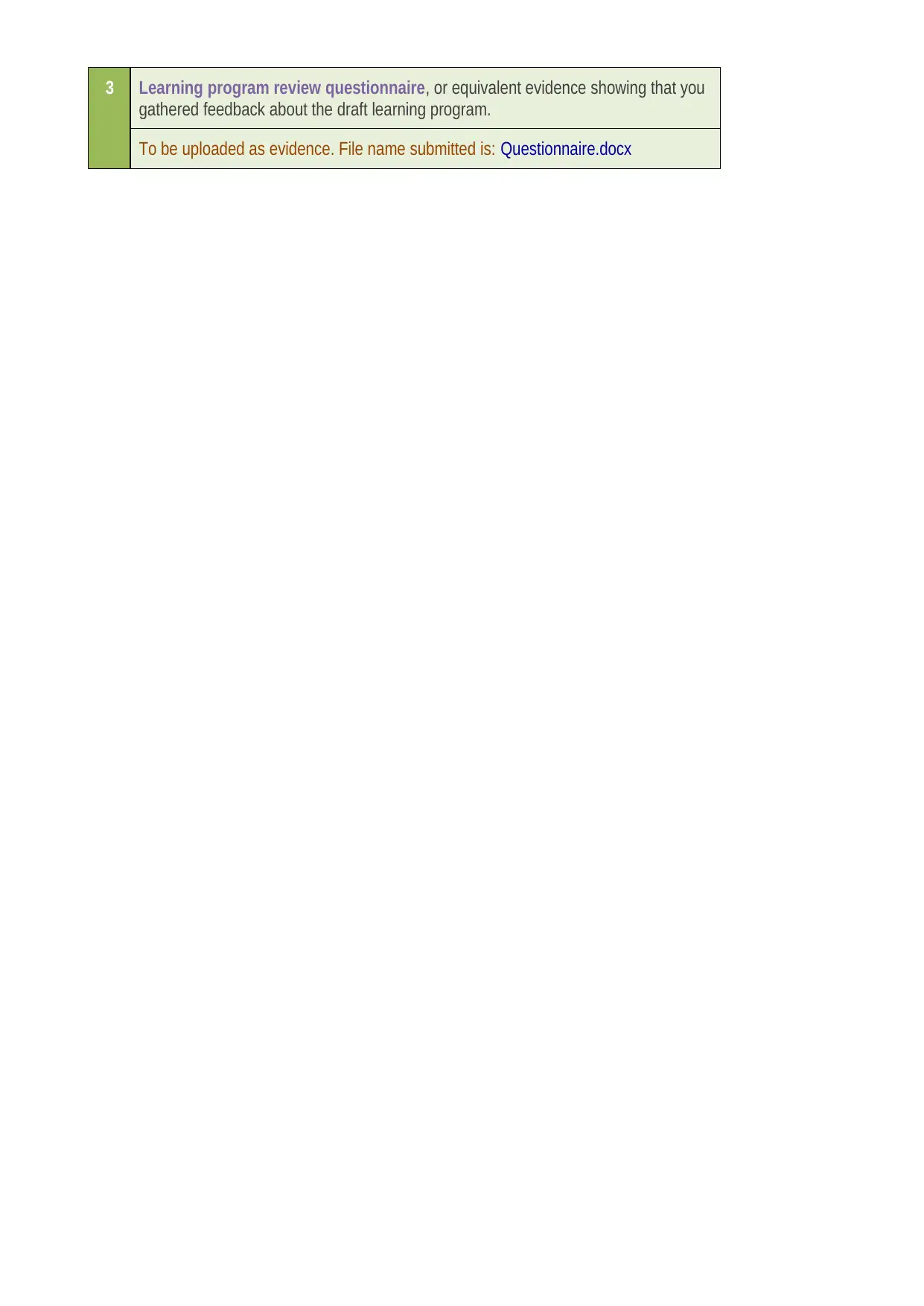
3 Learning program review questionnaire, or equivalent evidence showing that you
gathered feedback about the draft learning program.
To be uploaded as evidence. File name submitted is: Questionnaire.docx
gathered feedback about the draft learning program.
To be uploaded as evidence. File name submitted is: Questionnaire.docx
Paraphrase This Document
Need a fresh take? Get an instant paraphrase of this document with our AI Paraphraser

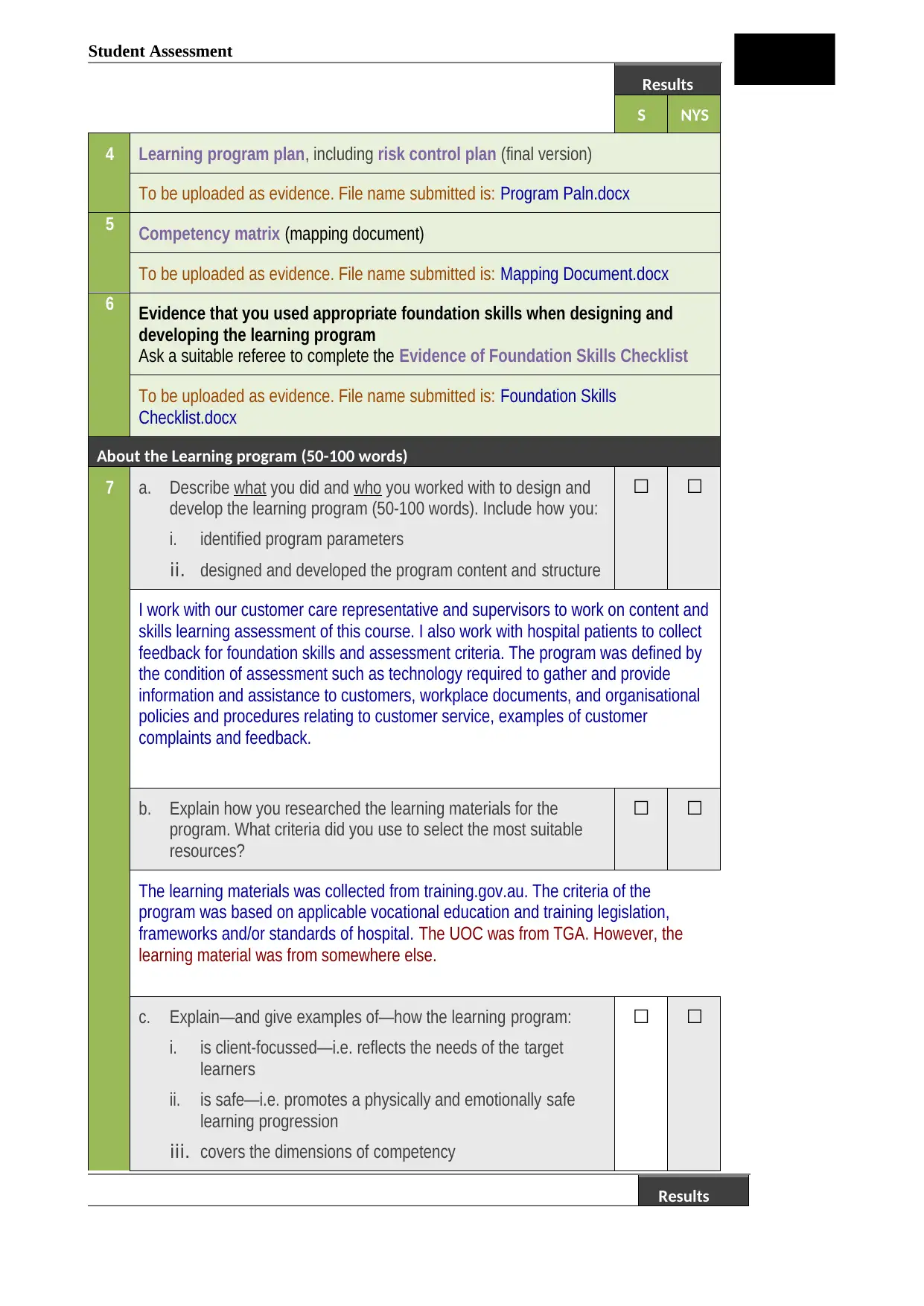
Student Assessment
Results
S NYS
4 Learning program plan, including risk control plan (final version)
To be uploaded as evidence. File name submitted is: Program Paln.docx
5 Competency matrix (mapping document)
To be uploaded as evidence. File name submitted is: Mapping Document.docx
6 Evidence that you used appropriate foundation skills when designing and
developing the learning program
Ask a suitable referee to complete the Evidence of Foundation Skills Checklist
To be uploaded as evidence. File name submitted is: Foundation Skills
Checklist.docx
About the Learning program (50-100 words)
7 a. Describe what you did and who you worked with to design and
develop the learning program (50-100 words). Include how you:
i. identified program parameters
ii. designed and developed the program content and structure
☐ ☐
I work with our customer care representative and supervisors to work on content and
skills learning assessment of this course. I also work with hospital patients to collect
feedback for foundation skills and assessment criteria. The program was defined by
the condition of assessment such as technology required to gather and provide
information and assistance to customers, workplace documents, and organisational
policies and procedures relating to customer service, examples of customer
complaints and feedback.
b. Explain how you researched the learning materials for the
program. What criteria did you use to select the most suitable
resources?
☐ ☐
The learning materials was collected from training.gov.au. The criteria of the
program was based on applicable vocational education and training legislation,
frameworks and/or standards of hospital. The UOC was from TGA. However, the
learning material was from somewhere else.
c. Explain—and give examples of—how the learning program:
i. is client-focussed—i.e. reflects the needs of the target
learners
ii. is safe—i.e. promotes a physically and emotionally safe
learning progression
iii. covers the dimensions of competency
☐ ☐
Results
Results
S NYS
4 Learning program plan, including risk control plan (final version)
To be uploaded as evidence. File name submitted is: Program Paln.docx
5 Competency matrix (mapping document)
To be uploaded as evidence. File name submitted is: Mapping Document.docx
6 Evidence that you used appropriate foundation skills when designing and
developing the learning program
Ask a suitable referee to complete the Evidence of Foundation Skills Checklist
To be uploaded as evidence. File name submitted is: Foundation Skills
Checklist.docx
About the Learning program (50-100 words)
7 a. Describe what you did and who you worked with to design and
develop the learning program (50-100 words). Include how you:
i. identified program parameters
ii. designed and developed the program content and structure
☐ ☐
I work with our customer care representative and supervisors to work on content and
skills learning assessment of this course. I also work with hospital patients to collect
feedback for foundation skills and assessment criteria. The program was defined by
the condition of assessment such as technology required to gather and provide
information and assistance to customers, workplace documents, and organisational
policies and procedures relating to customer service, examples of customer
complaints and feedback.
b. Explain how you researched the learning materials for the
program. What criteria did you use to select the most suitable
resources?
☐ ☐
The learning materials was collected from training.gov.au. The criteria of the
program was based on applicable vocational education and training legislation,
frameworks and/or standards of hospital. The UOC was from TGA. However, the
learning material was from somewhere else.
c. Explain—and give examples of—how the learning program:
i. is client-focussed—i.e. reflects the needs of the target
learners
ii. is safe—i.e. promotes a physically and emotionally safe
learning progression
iii. covers the dimensions of competency
☐ ☐
Results
⊘ This is a preview!⊘
Do you want full access?
Subscribe today to unlock all pages.

Trusted by 1+ million students worldwide
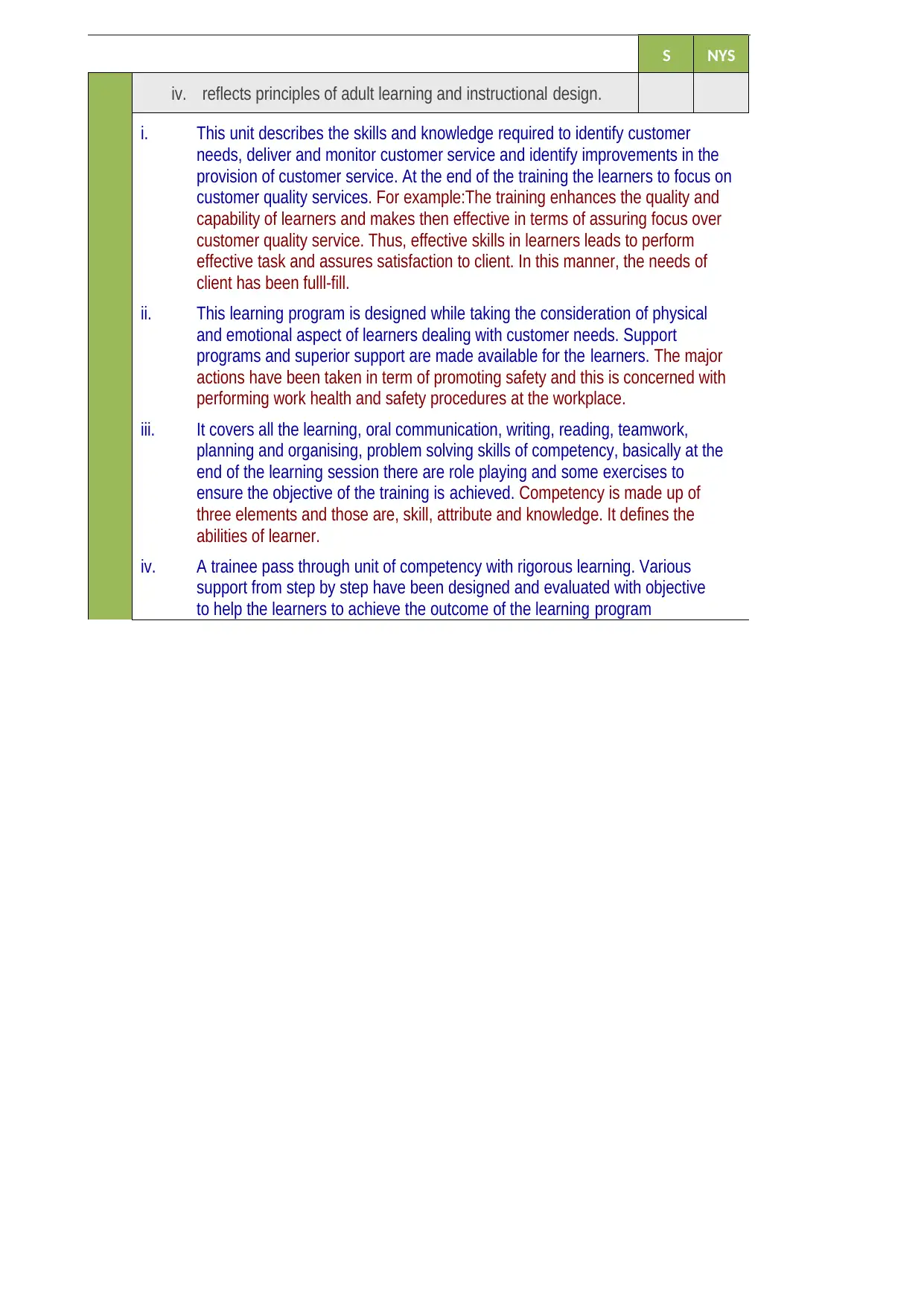
S NYS
iv. reflects principles of adult learning and instructional design.
i. This unit describes the skills and knowledge required to identify customer
needs, deliver and monitor customer service and identify improvements in the
provision of customer service. At the end of the training the learners to focus on
customer quality services. For example:The training enhances the quality and
capability of learners and makes then effective in terms of assuring focus over
customer quality service. Thus, effective skills in learners leads to perform
effective task and assures satisfaction to client. In this manner, the needs of
client has been fulll-fill.
ii. This learning program is designed while taking the consideration of physical
and emotional aspect of learners dealing with customer needs. Support
programs and superior support are made available for the learners. The major
actions have been taken in term of promoting safety and this is concerned with
performing work health and safety procedures at the workplace.
iii. It covers all the learning, oral communication, writing, reading, teamwork,
planning and organising, problem solving skills of competency, basically at the
end of the learning session there are role playing and some exercises to
ensure the objective of the training is achieved. Competency is made up of
three elements and those are, skill, attribute and knowledge. It defines the
abilities of learner.
iv. A trainee pass through unit of competency with rigorous learning. Various
support from step by step have been designed and evaluated with objective
to help the learners to achieve the outcome of the learning program
iv. reflects principles of adult learning and instructional design.
i. This unit describes the skills and knowledge required to identify customer
needs, deliver and monitor customer service and identify improvements in the
provision of customer service. At the end of the training the learners to focus on
customer quality services. For example:The training enhances the quality and
capability of learners and makes then effective in terms of assuring focus over
customer quality service. Thus, effective skills in learners leads to perform
effective task and assures satisfaction to client. In this manner, the needs of
client has been fulll-fill.
ii. This learning program is designed while taking the consideration of physical
and emotional aspect of learners dealing with customer needs. Support
programs and superior support are made available for the learners. The major
actions have been taken in term of promoting safety and this is concerned with
performing work health and safety procedures at the workplace.
iii. It covers all the learning, oral communication, writing, reading, teamwork,
planning and organising, problem solving skills of competency, basically at the
end of the learning session there are role playing and some exercises to
ensure the objective of the training is achieved. Competency is made up of
three elements and those are, skill, attribute and knowledge. It defines the
abilities of learner.
iv. A trainee pass through unit of competency with rigorous learning. Various
support from step by step have been designed and evaluated with objective
to help the learners to achieve the outcome of the learning program
Paraphrase This Document
Need a fresh take? Get an instant paraphrase of this document with our AI Paraphraser

Department Details:
Business
Author: Antje Janssen Date created: 14 January 2022 Date last updated: File name: /canvadocs-tmp/d20220318-45-gj8mth5/file.docx Ve
rsi
on
: 1
Template Details Author: VE Quality and Policy Date created: 09 November 2021 Date last updated: 26 November 2021 Location: PAVE Staff Wiki/Quality/Quality Life Cycle/Plan Version: 1 Page 7 of 15
Business
Author: Antje Janssen Date created: 14 January 2022 Date last updated: File name: /canvadocs-tmp/d20220318-45-gj8mth5/file.docx Ve
rsi
on
: 1
Template Details Author: VE Quality and Policy Date created: 09 November 2021 Date last updated: 26 November 2021 Location: PAVE Staff Wiki/Quality/Quality Life Cycle/Plan Version: 1 Page 7 of 15
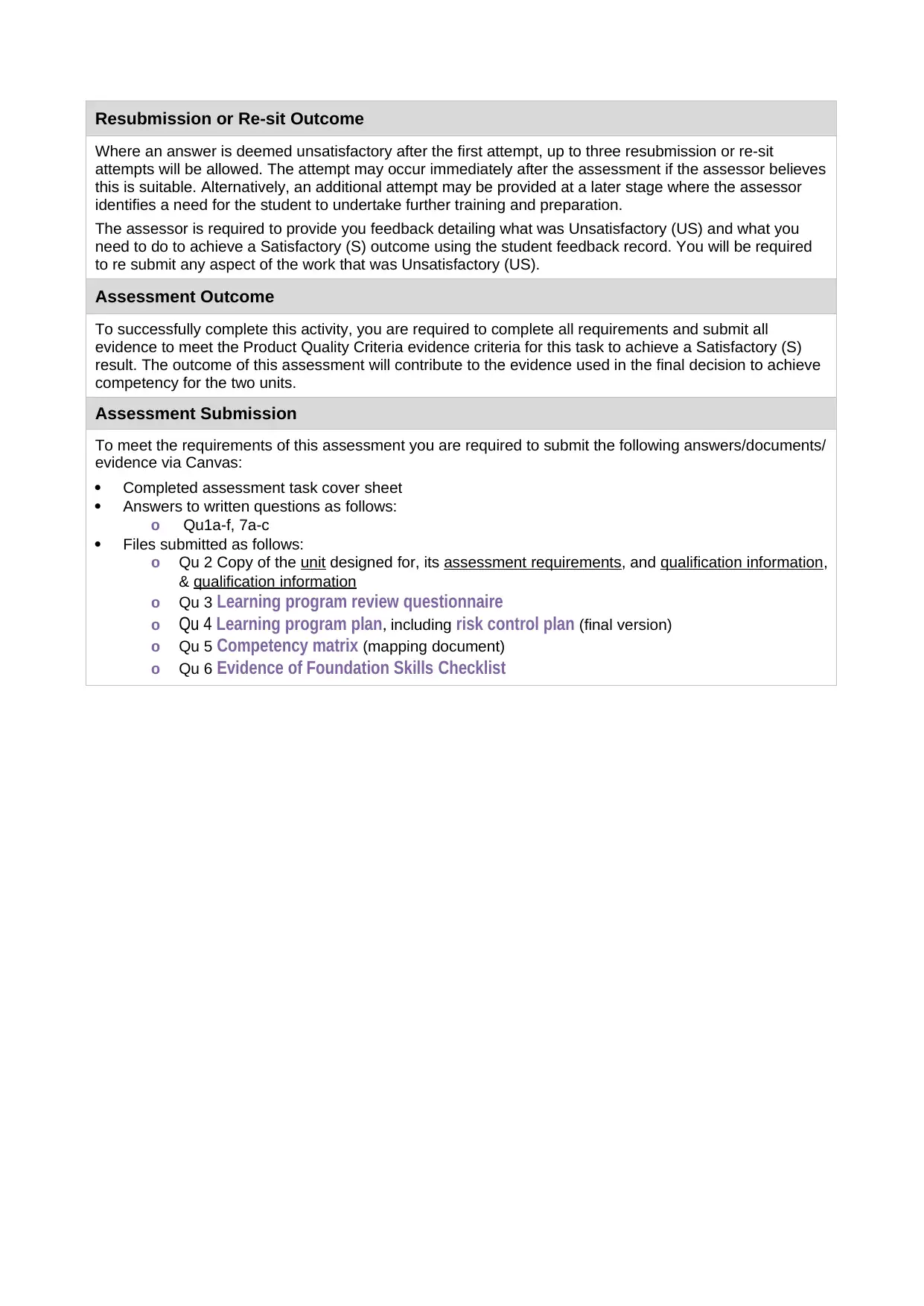
Resubmission or Re-sit Outcome
Where an answer is deemed unsatisfactory after the first attempt, up to three resubmission or re-sit
attempts will be allowed. The attempt may occur immediately after the assessment if the assessor believes
this is suitable. Alternatively, an additional attempt may be provided at a later stage where the assessor
identifies a need for the student to undertake further training and preparation.
The assessor is required to provide you feedback detailing what was Unsatisfactory (US) and what you
need to do to achieve a Satisfactory (S) outcome using the student feedback record. You will be required
to re submit any aspect of the work that was Unsatisfactory (US).
Assessment Outcome
To successfully complete this activity, you are required to complete all requirements and submit all
evidence to meet the Product Quality Criteria evidence criteria for this task to achieve a Satisfactory (S)
result. The outcome of this assessment will contribute to the evidence used in the final decision to achieve
competency for the two units.
Assessment Submission
To meet the requirements of this assessment you are required to submit the following answers/documents/
evidence via Canvas:
Completed assessment task cover sheet
Answers to written questions as follows:
o Qu1a-f, 7a-c
Files submitted as follows:
o Qu 2 Copy of the unit designed for, its assessment requirements, and qualification information,
& qualification information
o Qu 3 Learning program review questionnaire
o Qu 4 Learning program plan, including risk control plan (final version)
o Qu 5 Competency matrix (mapping document)
o Qu 6 Evidence of Foundation Skills Checklist
Where an answer is deemed unsatisfactory after the first attempt, up to three resubmission or re-sit
attempts will be allowed. The attempt may occur immediately after the assessment if the assessor believes
this is suitable. Alternatively, an additional attempt may be provided at a later stage where the assessor
identifies a need for the student to undertake further training and preparation.
The assessor is required to provide you feedback detailing what was Unsatisfactory (US) and what you
need to do to achieve a Satisfactory (S) outcome using the student feedback record. You will be required
to re submit any aspect of the work that was Unsatisfactory (US).
Assessment Outcome
To successfully complete this activity, you are required to complete all requirements and submit all
evidence to meet the Product Quality Criteria evidence criteria for this task to achieve a Satisfactory (S)
result. The outcome of this assessment will contribute to the evidence used in the final decision to achieve
competency for the two units.
Assessment Submission
To meet the requirements of this assessment you are required to submit the following answers/documents/
evidence via Canvas:
Completed assessment task cover sheet
Answers to written questions as follows:
o Qu1a-f, 7a-c
Files submitted as follows:
o Qu 2 Copy of the unit designed for, its assessment requirements, and qualification information,
& qualification information
o Qu 3 Learning program review questionnaire
o Qu 4 Learning program plan, including risk control plan (final version)
o Qu 5 Competency matrix (mapping document)
o Qu 6 Evidence of Foundation Skills Checklist
⊘ This is a preview!⊘
Do you want full access?
Subscribe today to unlock all pages.

Trusted by 1+ million students worldwide
1 out of 25
Related Documents
Your All-in-One AI-Powered Toolkit for Academic Success.
+13062052269
info@desklib.com
Available 24*7 on WhatsApp / Email
![[object Object]](/_next/static/media/star-bottom.7253800d.svg)
Unlock your academic potential
Copyright © 2020–2025 A2Z Services. All Rights Reserved. Developed and managed by ZUCOL.




